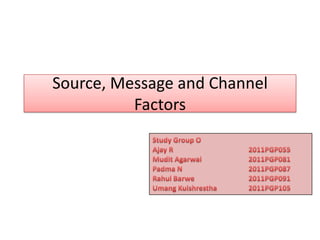
Source message and channel factors
- 1. Source, Message and Channel Factors
- 2. Persuasion Matrix • Independent variables: Controllable components of communication process • Dependent Variables: Steps a receiver goes through in being persuaded • This helps a marketer see how each controllable element interacts with the consumer’s responsive process
- 4. Source Factors Source: The person involved in communicating a marketing message Direct Source: A spokesperson who delivers a message and/or demonstrates a product or service Indirect Source: Doesn’t actually deliver a message but draws attention to and/or enhances the appearance of the ad Three basic categories of source attributes: credibility, attractiveness and power
- 5. Source Credibility Credibility is the extent to which the recipient sees the source as having relevant knowledge, skill, or experience and trusts the source to give unbiased, objective information Expertise and trustworthiness are two important dimensions to credibility Information from a credible source influences beliefs, opinions, attitudes, and/or behaviour through a process known as internalization, which occurs when the receiver adopts the opinion of the credible communicator since he or she believes information from this source is accurate
- 6. Source Attractiveness Attractiveness encompasses similarity, familiarity, and likability Source attractiveness leads to persuasion through a process of identification, whereby the receiver is motivated to seek some type of relationship with the source and thus adopts similar beliefs, attitudes, preferences, or behaviour
- 7. Source Power A source has power when he or she can actually administer rewards and punishments to the receiver The source must be perceived as being able to administer positive or negative sanctions to the receiver (perceived control) The receiver must think the source cares about whether or not the receiver conforms (perceived concern) The receiver’s estimate of the source’s ability to observe conformity is also important (perceived scrutiny) When a receiver perceives a source as having power, the influence process occurs through a process known as compliance
- 8. MESSAGE STRUCTURE An important aspect of message strategy is knowing the best way to communicate these points and overcome any opposing viewpoints audience members may hold
- 9. Order Of Presentation • Presenting the strongest arguments at the beginning of the message assumes a primacy effect is operating, whereby information presented first is most effective. • Putting the strong points at the end assumes a recency effect, whereby the last arguments presented are most persuasive Ad message recall as a function of order of presentation
- 10. Conclusion Drawing: • Messages with explicit conclusions are more easily understood and effective in influencing attitudes • The effectiveness of conclusion drawing may depend on the target audience, the type of issue or topic, and the nature of the situation Message Sidedness: • A one-sided message mentions only positive attributes or benefits • One-sided messages are most effective when the target audience already holds a favourable opinion about the topic • A two-sided message presents both good and bad points • Two-sided messages are more effective when the target audience holds an opposing opinion or is highly educated Refutation: • The communicator presents both sides of an issue and then refutes the opposing viewpoint • They are more effective than one-sided messages in making consumers resistant to an opposing message Verbal vs. visual messages: • The use of a visual that is inconsistent with the verbal content leads to more recall and greater processing of the information presented
- 11. • The practice of either directly or indirectly naming competitors in an ad and comparing one or more specific Comparative Advertising attributes • Ads sometimes use fear appeals to evoke this emotional response and arouse individuals to take steps to remove the Fear Appeals threat • Humorous ads are often the best known and best Humor remembered of all advertising messages Appeals
- 12. CHANNEL FACTORS While a variety of methods are available to transmit marketing communications, they can be classified into two broad categories, personal and non-personal media. Information received from personal influence channels is generally more persuasive than information received via the mass media.
- 13. Effects of Alternative Mass Media: • The various mass media that advertisers use to transmit their messages differ in many ways, including the number and type of people they reach, costs, information processing requirements, and qualitative factors • Information from ads in print media, such as newspapers, magazines, or direct mail, is self-paced; readers process the ad at their own rate and can study it as long as they desire. • In contrast, information from the broadcast media of radio and television is externally paced; the transmission rate is controlled by the medium Effects of context and environment: • A qualitative media effect is the influence the medium has on a message media • Buyers are advised to follow the conventional wisdom of placing their ads during “feel- good” programming, especially if the message is intended to work through a central route to persuasion. • Messages intended to operate through a peripheral route to persuasion might be more effective if they are shown during more negative programs, where presumably viewers will not analyse the ad in detail because of their negative mood state Clutter: • Clutter is the amount of advertising in medium • Clutter is of increasing concern to advertisers since there are so many messages in various media competing for the consumer’s attention • Clutter has become a major concern among television advertisers as a result of increases in non-program time and the trend toward shorter commercials
